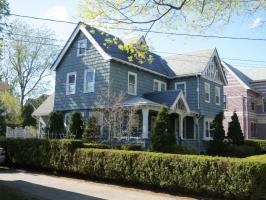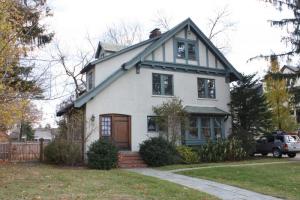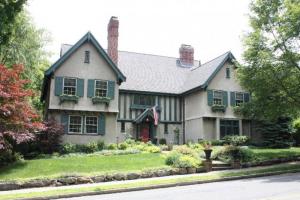English Revival/Arts and Crafts: 1910-1930
English Revival/Arts and Crafts: 1910-1930
Vying for popularity with the Colonial Revival in the early 20th century were a number of eclectic styles based loosely on English prototypes and designed for a more picturesque effect. The buildings lack the symmetry of the Colonial and typically display steeply-pitched gables with decorated vergeboards, half-timbering and diamond-paned windows.
Examples Found in Belmont:

Dohs-Lane House, 1900 | 60 Oak Ave.
The house at 60 Oak Avenue is an early English Revival dwelling constructed in 1900 which also displays elements of the concurrent Craftsman style as well. The 2 ½-story, cross-gable dwelling is sheathed in (artificial?) wood shingles and is capped by a gable roof with decorative rake boards, projecting eaves and exposed rafters on the lateral eaves. The main front gable has more ornate half timbering combining vertical and curved stickwork and a bottom dentil-like molding.

James Cole House, 1911 | 15 Clover St.
The house at 15 Clover Street is one of a handful of architect-designed, stucco-finished houses in the Clark Hill neighborhood. It consists of a 2 ½-story gablefront that is two bays wide with Tudor Revival detailing in the front gable including decorative half timbering, a central finial, exposed beam ends, a wide frieze and a bargeboard with flared ends. To the north of this gablefront, the bargeboard is extended and the sloping roof shelters what was originally an open archway with the main entrance to the house recessed within.

Ticknor-Farnham House, 1912 | 200 Common St.
200 Common Street is a good (and fairly early) example of the English Revival style, constructed in 1912. Inspired loosely by English cottages, the two-story stuccoed house is nearly symmetrical with a central bay (half-timbered on the second story) flanked by projecting gable-front wings forming a U-shaped plan. The gabled wings have second stories that overhang the first and decorative vergeboards that are flared at the ends with pendants and purlins with braces. This effect is repeated on a smaller scale on the vergeboard on the entry porch.


